We’re off to the races! Place your bets, enjoy the concessions, and root for your favorite horse!
What Is Long Shot: The Dice Game?
Long Shot: The Dice Game is a roll-and-write game for 1 to 8 players, ages 14 and up, and takes about 25 minutes to play. It’s currently seeking funding on Kickstarter, with a pledge level of $25 for a copy of the game. While the game is adapted from the original Long Shot game, you don’t need any knowledge of that one to play the roll-and-write version. The game can be played by younger players—I played with my 7-year-old—but they may need assistance with calculating scores or understanding the concept of the odds.
Long Shot: The Dice Game was designed by Chris Handy and published by Perplext under its Roland Wright imprint, with illustrations by Clau Souza.
New to Kickstarter? Check out our crowdfunding primer.

Long Shot: The Dice Game Components
Note: My review is based on a prototype copy, though the publisher said it should be fairly representative of the production copy.
Here’s what comes in the box:
- Racetrack board
- 8 Player mats
- 8 Horse tokens
- 8 Dry Erase markers
- 8 Starting cards
- 16 Horse cards
- Horse die (8-sided)
- Movement die (6-sided)
- Solo board
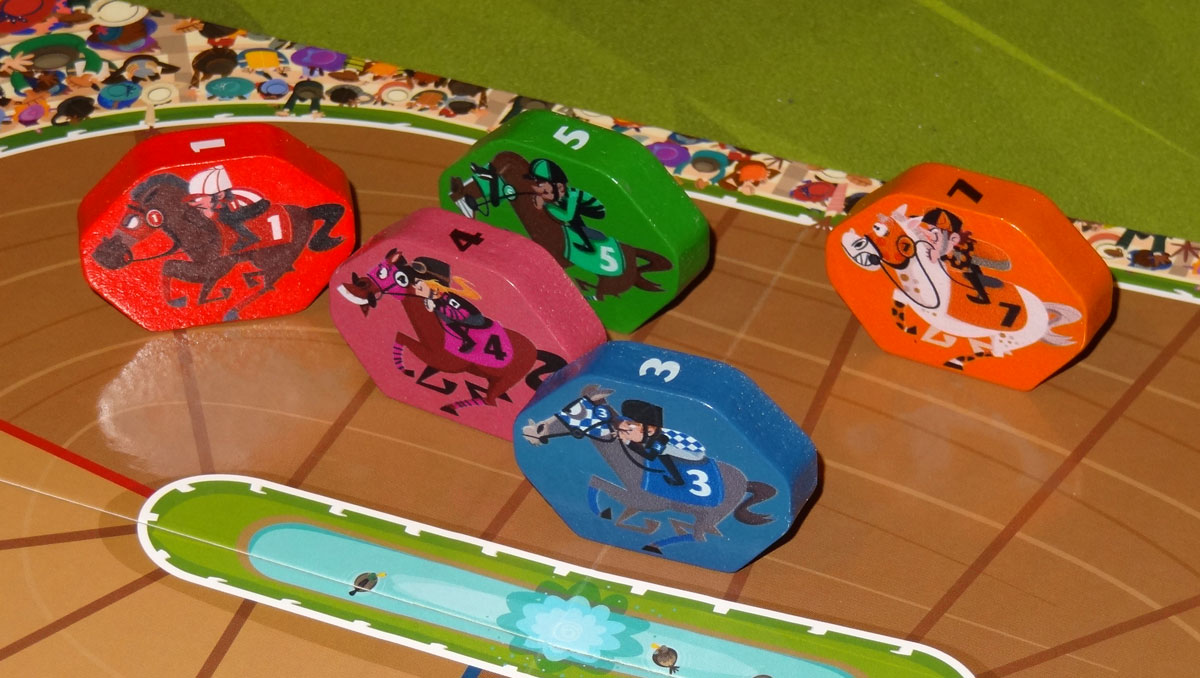
The horse tokens are sort of oval-shaped tokens, with the horse illustration printed on both sides and the horse’s number printed on the top. They’re also each a different color, so you can see at a glance which horse is which. The illustrations have a cartoony style, but I appreciate that Clau Souza did some research and patterned some of them after real-life jockeys, including some women and people of color who may not have been riding in the 1930s (the era of the game) but made history later on in the sport.
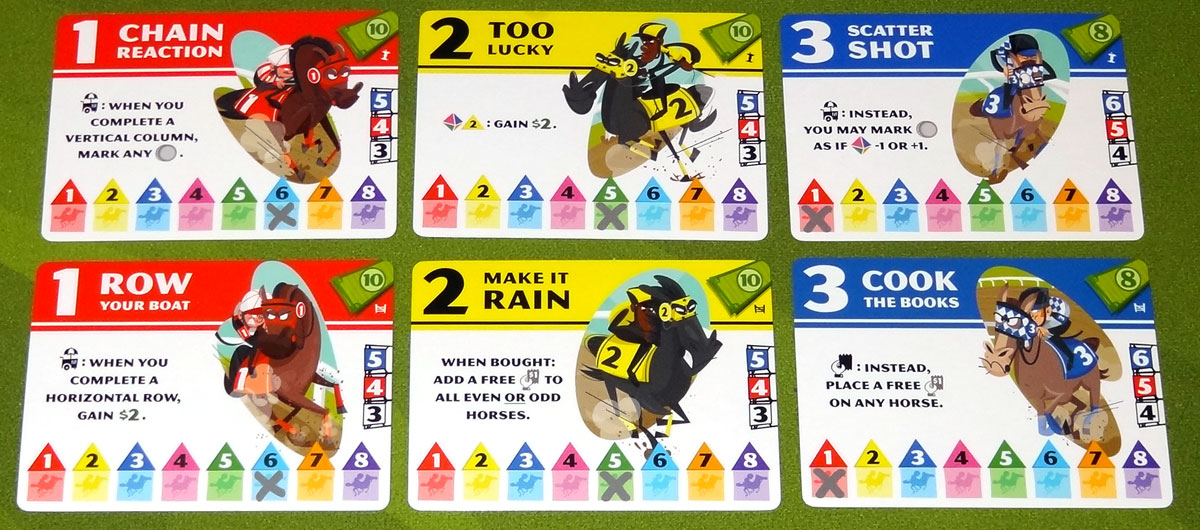
There are two sets of horse cards (with a 3rd set for Kickstarter backers), and each horse has a name and a special ability. I like the fact that the names refer to the abilities. Also, each set of cards has its own illustration of the horse and jockey, so even though Chain Reaction and Row Your Boat are both the red #1 horse, the card doesn’t re-use the same image.

The two dice are custom dice: the 8-sided horse die has both the color and number of the horse, and the 6-sided movement die has 1-2-2-2-3-3 as its faces.
The player mats are all made of glossy cardstock, which works well with the dry erase markers. There’s a lot to look at on the player mats, but there’s a handy reference showing the different actions players can take, and the scoring chart at the far right reminds you what you’ll score for at the end of the game.
The racetrack board is a quad-fold board: it’s not a huge board, and is mostly just to display the position of all the horses around the 15 sections of the racetrack. There are also three podium spaces indicating the prize money for the 1st, 2nd, and 3rd place winners.
The whole thing comes in a pretty compact box with a magnetic flap lid—it’s a nice package (comparable to a thick hardcover book, though a bit narrower) and is the same size as Roland Wright, from the same publisher.
How to Play Long Shot: The Dice Game
You can download a copy of the rulebook here, and it is also available to try on Tabletop Simulator.
The Goal
The goal of the game is to have the most money at the end of the game (when three horses have passed the finish line).
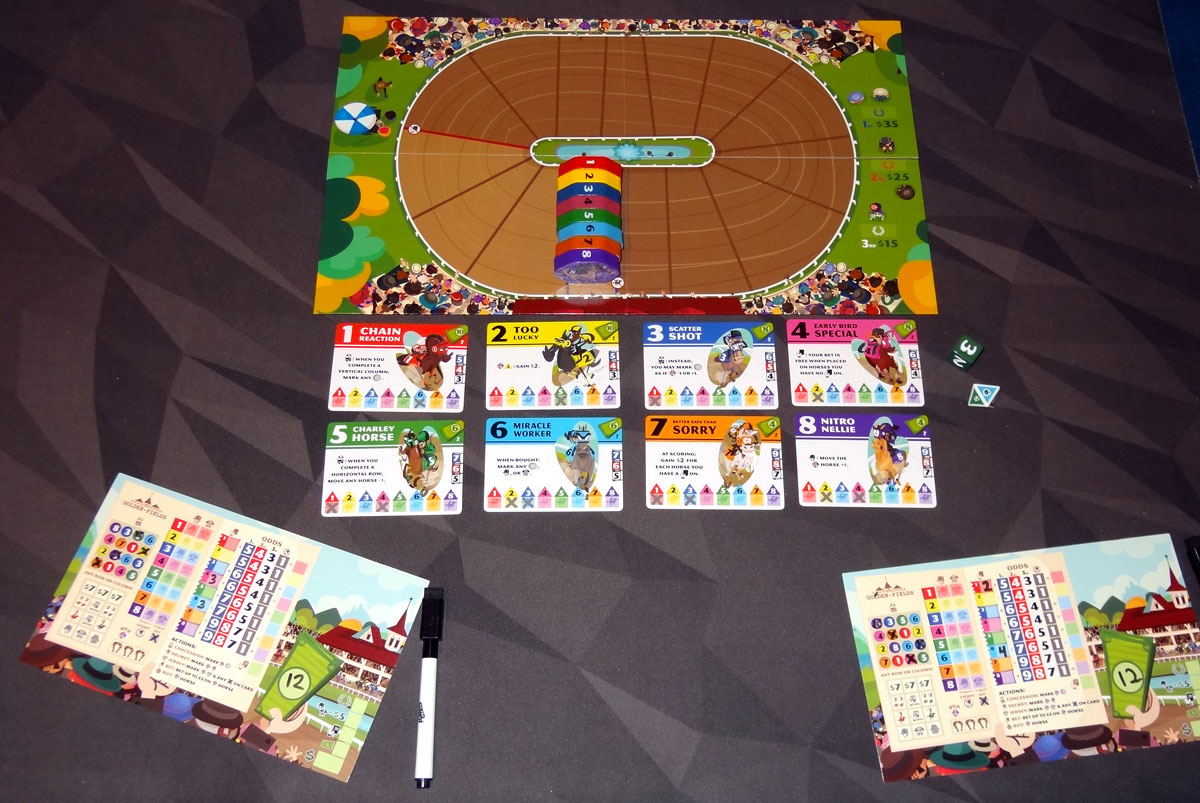
Setup
Place the racetrack in the center of the play area, and put all of the horse tokens just behind the starting line. Choose a set of horse cards to use and place all of them next to the racetrack where everyone can see them. Everyone starts with $12, written in the dollar bill on the right side of the board.

Give each player a player mat, a marker, and a random starting card. Each player marks the four concessions shown on their starting card, and also copies the two starting bets on to their mats. The player who most recently made a bet is first player and takes the dice.
Gameplay
Each turn, the active player rolls the dice, moves horses, and then every player in turn order takes an action based on the horse die.
The player rolls both dice: the horse die indicates which horse moves, and the movement die indicates how many spaces to move it. In addition, the active horse will also cause some other horses to move as well. Check the card matching the horse die, and for each number on that card with an X on it, move the corresponding horse 1 space. (Always resolve these bonus movements in numerical order, from low to high.)
Then, each player in turn order takes one action: concessions, helmet, jersey, bet, or buy.
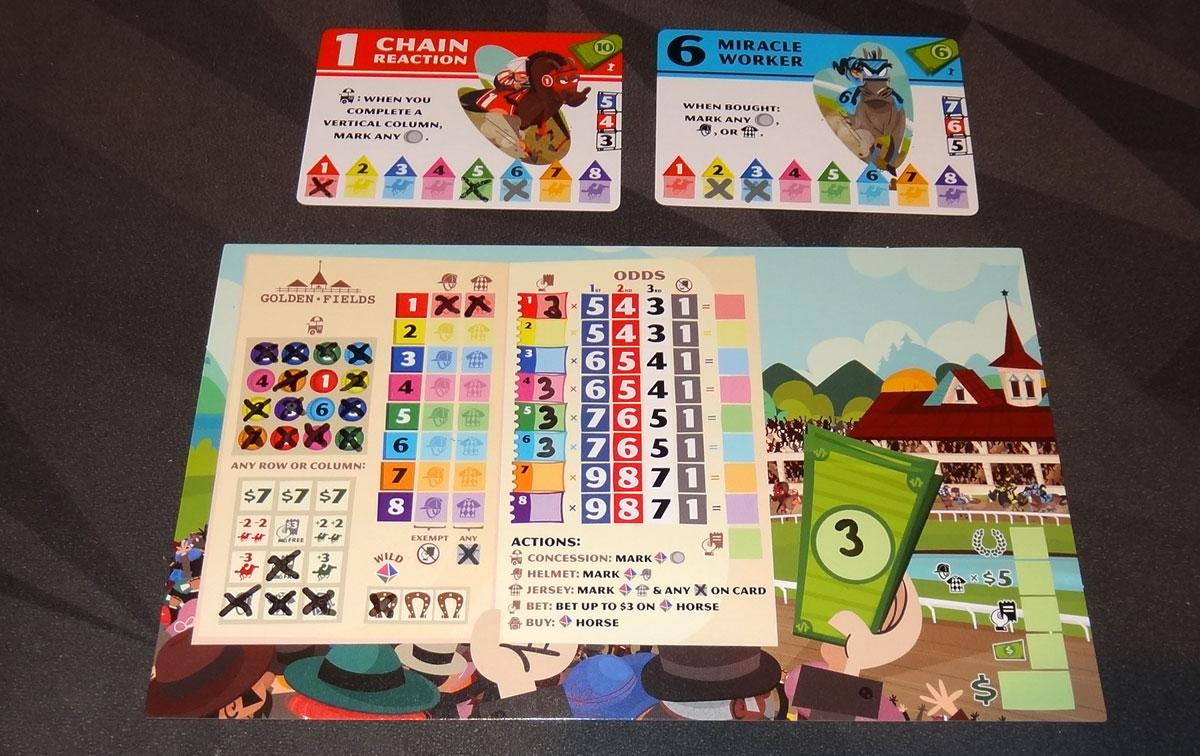
Concessions: cross out a circle in your concessions area matching the horse die. Each time you complete a row or column, you earn one of the bonuses in the chart below the concessions. Bonuses include gaining money, moving horses forward or backward, placing bets, getting a helmet, a jersey, or even getting a horse for free.
Helmet: Mark off the helmet space for the active horse. Normally, you may not add to a bet on a horse that has passed the red “no-bet” line on the track, but if you have a helmet, you can continue betting on that horse (until it crosses the finish line).
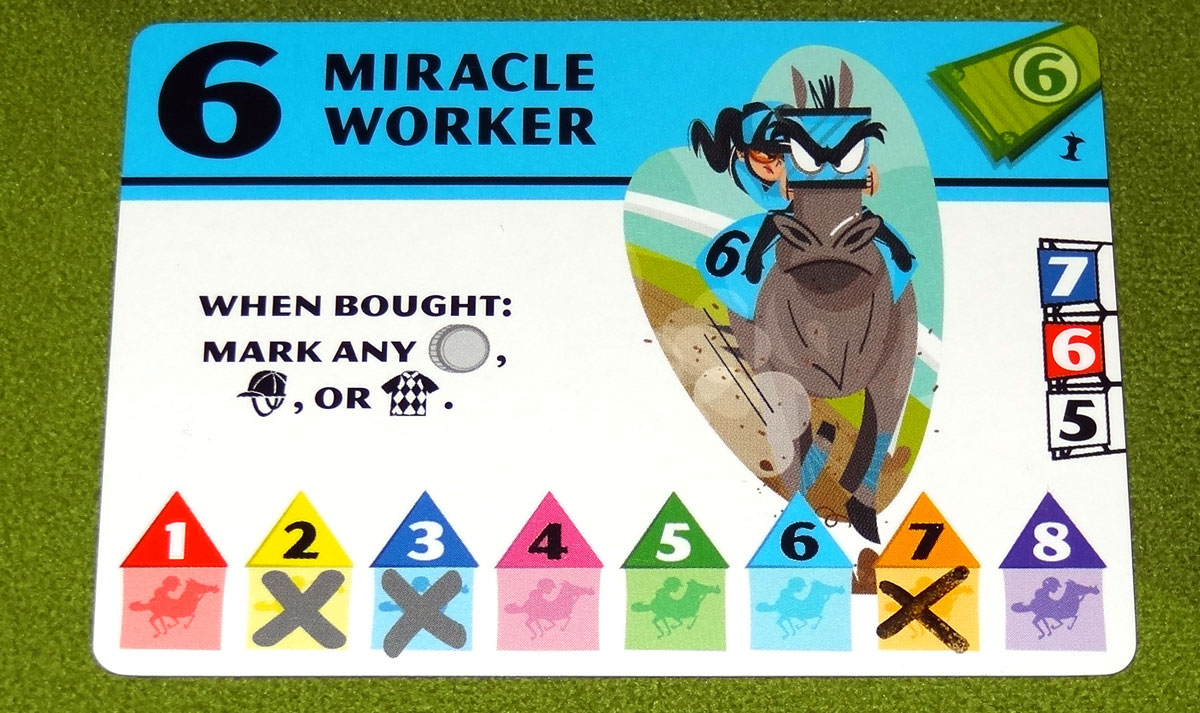
Jersey: Mark off the jersey space for the active horse. You also add an X to that horse’s card.
Bet: Increase your bet on the active horse, up to $3. Subtract your bet from your balance and increase the bet on that horse.

Buy: Spend money from your balance to buy the active horse (if nobody owns it yet). Each horse card has a price tag on the top right. Place the horse card in front of you: you now have access to that horse’s special ability, and you will also win prize money if the horse places in the top 3.
You also have 3 “wild” horseshoes on your player mat: you may cross off a horseshoe in order to use any number instead of the number shown on the horse die. You may also skip an action on your turn to recover a wild, erasing the mark so you can spend it again on a future turn.
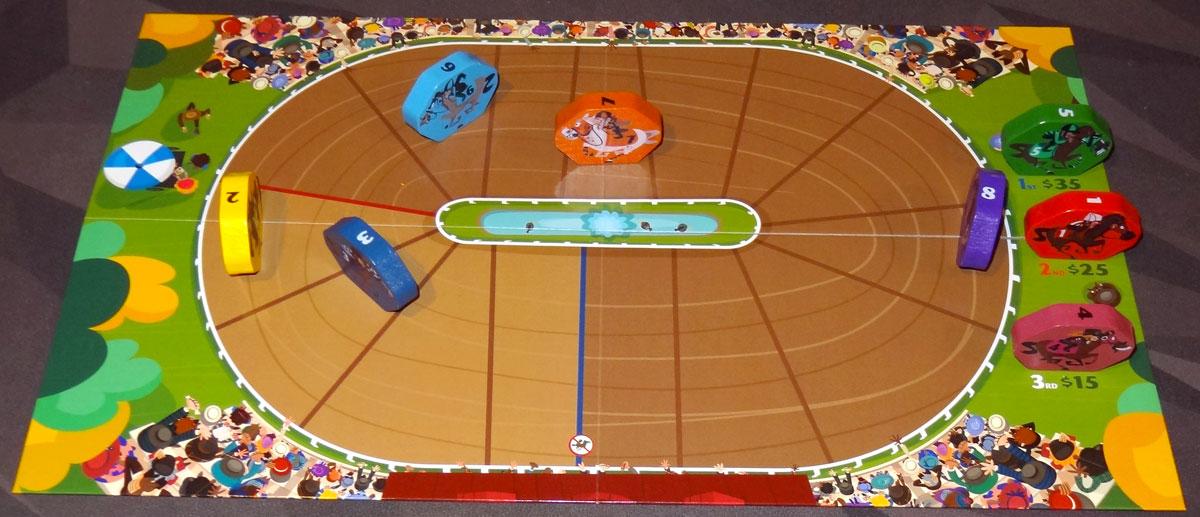
Game End
When three horses have crossed the finish line, finish that turn (so every player gets an action). Place horses on the corresponding podium spaces.

Tally up your scores:
- If you own a winning horse, earn prize money ($35 for 1st, $25 for 2nd, $15 for 3rd)
- For each horse with both a helmet and jersey, earn $5.
- Multiply your bet on each horse by the odds for its place. Horses that make it past the no-bet line but do not place earn the bet back; horses that do not make it to the no-bet line earn $0.
- Add any remaining money you have in your balance.
The highest total wins, with ties going to the owner of the horse that placed higher in the race.
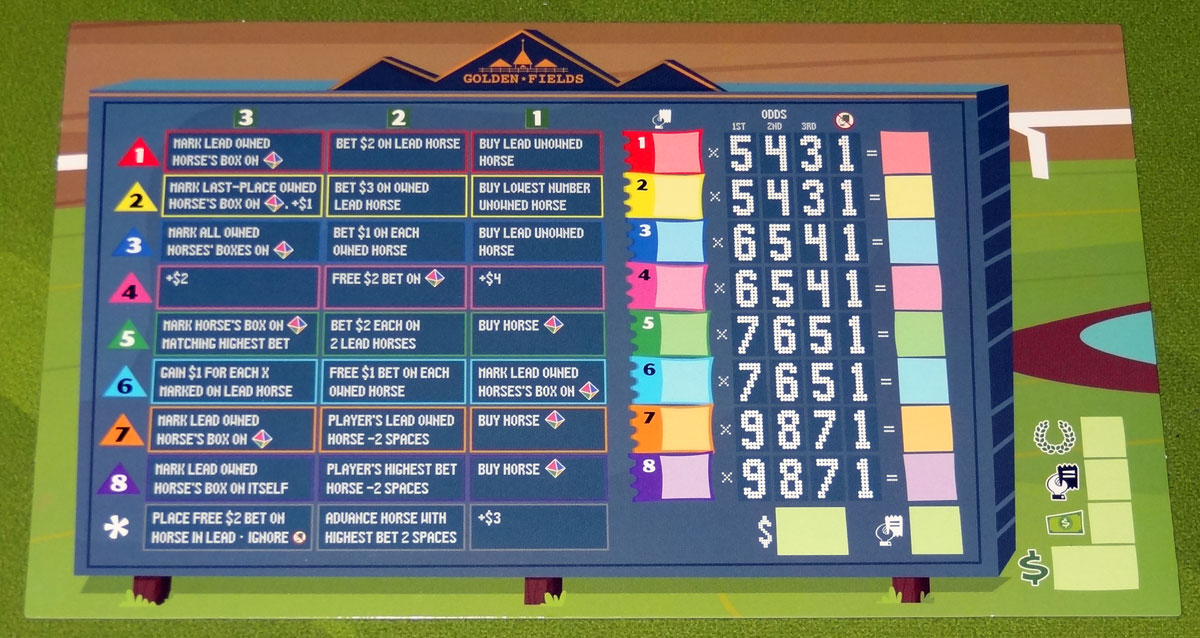
Solo Game
The solo game is played against Roland Wright (star of his own game and, apparently, also a racing tycoon), using a chart. You use a starting card to set Roland’s starting bets, but he doesn’t have a concessions grid. He does, however, start with $20.
Each time you roll the dice, you take your turn first and then consult the grid to see what Roland’s action will be. If he can’t take the action for whatever reason, then he does the default action in the bottom row. Your goal is the same as in the multiplayer game: end up with the most money.
Why You Should Play Long Shot: The Dice Game
I’ll be honest: most of what I know about horse racing comes from a single episode of Leverage, and that was more about scamming the bad guy by selling him his own horse. I do understand the idea of betting on a winner and how some horses are favored to win (and therefore earn less on their bets than the long shots), but that’s about it. So, while watching horses race and placing bets on them doesn’t immediately give me pause the way that, say, a game about colonialism would, I honestly don’t know if the theme raises any red flags, like whether horses are treated inhumanely or something like that. I do tend to associate horse racing—particularly in Roland Wright’s era, with three-piece suits and fancy hats—as a pastime for the wealthy, but I suppose this game is at least humane (because they’re not real horses!) and also won’t leave you destitute if you make a bad bet. (At most, you’re out $25 plus shipping.)
That said, Long Shot looks like a pretty solid bet to me. I’ve played it several times since receiving the prototype: with my daughter, with some friends over videoconferencing, and then using the Tabletop Simulator module once that was available. While it does take a little bit of explanation of all the different actions before you can get started, pretty soon you’ll get into the excitement of cheering for your horse, debating whether to place another wager, and hitting that concessions stand again. (My daughter enjoyed it so much that she would also set it up herself just to watch a horse “race” by herself, rolling the dice to see which horses would win.)
There are some fun decisions to make throughout. Each turn, you’re just taking a single action, and the horse die determines which number you’ll get to use (except when you use a wild), so that helps to prevent too much analysis paralysis. As the game progresses, sometimes your actions will be more limited: if you already have a hat and a jersey for horse #4 and that number comes up again, you know you’ll need to do something else.

Visiting the concessions stand is pretty simple, because you just check off that number, and see if you finish a row or column. It can be very valuable to get that free horse bonus early on, because horses can cost as much as $10! (Thematically, it’s pretty amusing to me that you could get a free horse by buying four snacks—that’s a pretty great punch card!) Some of the horses have additional abilities related to concessions, so if you buy one of those horses it gives you an extra incentive to use that action often. The other bonuses can be very powerful, too: moving horses backward or forward at just the right moment could tip the scales in your favor. And a bonus $7 is nothing to sneeze at, either.
The helmet itself may not seem like a huge deal, but when a horse makes a surprise leap across that no-bet line and you realize you want to increase your wager, you’ll be glad you took the helmet earlier! Plus, if you get the matching jersey, it’s worth $5 at the end of the game.
The jerseys are where things get really wild, because that’s how you start manipulating the odds. At the start of the game, the lower numbered horses are favored to win and have lower payouts, because their numbers are already marked on more of the horses. For instance, 1 and 2 are already marked on 3 cards each, which means that there’s a pretty good chance that they’ll get bonus moves. On the other hand, poor 7 and 8 aren’t marked at all, which means they’ll only move if somebody rolls their number. Getting a jersey lets you mark an X, making a horse more likely to move. If you managed to get all 8 jerseys and used them all to mark #8, you’d guarantee that Nitro Nellie would move a space on every turn—though if you do that, make sure you have enough actions to place some bets on that horse, too. (Marking the horse’s number on its own card means that when its number is rolled, it moves an extra space!) I liked the way that the payouts reflect the bonus moves—it’s a clever way of tying the bets to the odds of the horse winning.
Each player starts off with bets on two horses, for a total of $6. But, of course, as the game progresses, you might see some other horses pulling into the lead. You can bet on as many horses as you want, but of course you only start with $12, and the only way to get any more money during the game is by using a concessions bonus, so budget wisely! Don’t forget to save up if you plan to buy a horse: those horse abilities can be very useful, and the prize money for owning a winning horse can be a significant fraction of your final score.
So far I’ve only had up to 4 players at a time, and the game goes pretty quickly. I imagine an 8-player game would be pretty rowdy and a lot of fun, but I also think it would increase the play time a bit—even if everyone thinks pretty quickly about their actions, doubling the number of players will just take a bit longer to resolve everything. It also means that many more players could be using their concessions bonus to move horses back. In one game I played, there was a horse that took an early lead, and got pulled back from the finish line several times, because only the player who actually owned the horse wanted it to win. That did make the game drag on a little bit, but because each concessions bonus can only be used once per player, eventually somebody will cross that finish line.

I haven’t ever played the original Long Shot board game, which is now out of print, but I’ve really enjoyed this roll-and-write version. I’ve had games where the whole pack was neck-and-neck throughout the race, and games where there was a runaway leader (and some horses that barely made it out of the starting gate). Swapping out the set of horse cards is a neat way to tweak the feel of the game a bit because the horses have different abilities. If your gaming group enjoys the roll-and-write genre, Long Shot: The Dice Game could be a fun title to try out, especially if you like a bit of press-your-luck. There’s a good amount of interaction—not directly, since you can’t mess with another player’s board, but in terms of manipulating which horses are likely to win based on which bets have been placed, and also in competing to buy the winning horses.
For more information or to make a pledge, visit the Long Shot: The Dice Game Kickstarter page!
Click here to see all our tabletop game reviews.
![]() To subscribe to GeekDad’s tabletop gaming coverage, please copy this link and add it to your RSS reader.
To subscribe to GeekDad’s tabletop gaming coverage, please copy this link and add it to your RSS reader.
Disclosure: GeekDad received a prototype of this game for review purposes.






I like this game